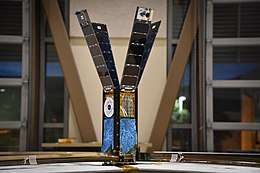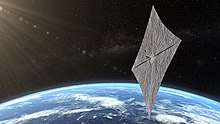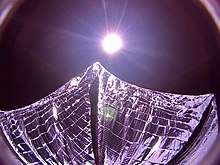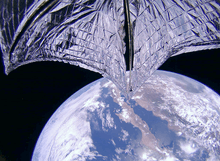LightSail
LightSail is a project to demonstrate controlled solar sailing within low Earth orbit using a CubeSat. The project was developed by The Planetary Society, a global non-profit organization devoted to space exploration.[5] It consists of two spacecraft—LightSail 1 and LightSail 2. LightSail 1 was an engineering demonstration mission designed to test its new sail deployment method in space, it did not perform solar sailing. LightSail 2 is a fully functional spacecraft intended to demonstrate true solar sailing[6] and incorporates the lessons learned from LightSail 1. LightSail is a follow-on project to Cosmos 1—a solar-sail spacecraft designed by The Planetary Society in the early 2000s, which was destroyed during a launch failure in 2005.
 LightSail 2 after a boom deployment test | |
| Names | LightSail 1, LightSail 2[1] |
|---|---|
| Mission type | Technology demonstration |
| Operator | The Planetary Society |
| COSPAR ID | 2019-036AC |
| Website | sail |
| Mission duration | LightSail 1: 25 days LightSail 2: ~1 year (planned)[2] |
| Spacecraft properties | |
| Spacecraft type | Solar sail |
| Bus | 3U CubeSat |
| Manufacturer | Stellar Exploration, Inc., Ecliptic Enterprises Corporation, Cal Poly San Luis Obispo |
| Dimensions | Core: 10 cm × 10 cm × 30 cm (3.9 in × 3.9 in × 11.8 in) Sail: 32 m2 (340 sq ft) |
| Start of mission | |
| Launch date | LightSail 1: 20 May 2015 LightSail 2: 25 June 2019[3] |
| Rocket | LightSail 1: Atlas V LightSail 2: Falcon Heavy |
| End of mission | |
| Decay date | LightSail 1: 14 June 2015[4] |
Both LightSail spacecraft measure 10 cm × 10 cm × 30 cm (3.9 in × 3.9 in × 11.8 in) in their stowed configuration. After sail deployment, the total area of each spacecraft is 32 square meters (340 sq ft).[7]
History
In 2005, The Planetary Society attempted to send a solar sail satellite named Cosmos 1 into space, but the spacecraft's Russian Volna launch vehicle failed to reach orbit.[8] In 2009, the Society began working on a CubeSat-based solar sail based on NASA's NanoSail-D project,[9] which was lost in August 2008 due to the failure of its Falcon 1 launch vehicle.[10] (A second unit, NanoSail-D2, was successfully deployed in early 2011.)
In 2011, the LightSail project passed its critical design review, which was conducted by a team including JPL project veterans Bud Schurmeier, Glenn Cunningham, and Viktor Kerzhanovich, as well as Dave Bearden of Aerospace Corporation.[11]
On May 20, 2015, LightSail 1 (formerly called LightSail-A[1]) launched. It deployed its solar sail on 7 June 2015 and re-entered the atmosphere, as planned, on 14 June 2015.
In March 2016, The Planetary Society announced a new naming convention for the spacecraft: the test flight (originally LightSail-A) was renamed LightSail 1, with the second spacecraft named LightSail 2.[1]
LightSail 2 launched as a secondary payload on the Space Test Program (STP-2) on a Falcon Heavy rocket on 25 June 2019. It deployed its solar sail on July 23, and successfully downlinked photographs of the deployed sail on July 24.[6]
The Society has stated it has no plans for a LightSail 3.[12]
Design

As a solar sail, LightSail's propulsion relies on solar radiation and not the charged particles of the solar wind.[13] Solar photons exert radiation pressure on the sail, which produces an acceleration on the spacecraft relative to the ratio of the sail's area to its mass. As such, the design challenge was to maximize the surface area of the sail while minimizing the mass of the spacecraft—all while adhering to the standard 3-unit CubeSat size limitation.
LightSail's modular design is based on a modular 3-unit CubeSat, a small satellite format created for university-level space projects. One CubeSat-sized module carries the cameras, sensors and control systems, and the other two units contain and deploy the solar sails.[14]
The spacecraft contains four triangular sails, which combine to form a rectangular-shaped surface. The sails are made of Mylar, a reflective polyester film.[15]
LightSail has multiple configurations. It was launched in a stowed configuration with its sails folded within the spacecraft. After launch, it enters an intermediate phase by deploying a small antenna and flipping open its solar panels. This exposes the cameras and reveals the stowed solar sails. To achieve its final "solar sailing" configuration, LightSail extends four 4-meter cobalt alloy booms that slowly spread open the mylar sail material.
Using an internal reaction wheel, LightSail 2 is able to orient itself against the Sun using Earth's magnetic field as a guide. By "tacking" in and out of the Sun, it can control the force on its sail and thus change its orbit.
Costs and funding
The entire LightSail project cost US$7 million over 10 years and was paid for by approximately 40,000 individual donors,[16] including $1.24 million raised from a successful Kickstarter campaign in 2015.[17] Launch costs were supported by NASA's Educational Launch of Nanosatellites program (LightSail 1) and the Air Force Research Laboratory's University Nanosat Program (LightSail 2).[14]
LightSail 1

A preliminary technology demonstrator spacecraft, LightSail 1 (formerly LightSail-A[1]), was launched as a secondary payload aboard a United Launch Alliance Atlas V rocket at 15:05 UTC on 20 May 2015 from Cape Canaveral Air Force Station, Florida.[18][19] The mission delivered the satellite to an orbit where atmospheric drag was greater than the force exerted by solar radiation pressure.[20]
Two days after the launch, however, the spacecraft suffered a software malfunction, which made it unable to deploy the solar sail or to communicate.[21] On 31 May 2015, The Planetary Society reported having regained contact with LightSail 1.[22][23] After the solar panels were deployed on 3 June 2015, communications with the spacecraft were lost once more on 4 June. In this case, a fault with the battery system was suspected.[24] Contact was then reestablished on 6 June,[25] and the sail deployment was initiated on 7 June.[26] At a conference on 10 June 2015, after photos of deployment were downloaded, the test flight was declared a success.[27] The spacecraft reentered the atmosphere on 14 June 2015, ending the test flight.[28][29]
LightSail 2

LightSail 2 was launched on 25 June 2019 and deployed by the Prox-1 carrier satellite into a much higher low Earth orbit than LightSail 1, at over 720 km (450 mi) orbital altitude.[14][30] It was to demonstrate controlled solar sailing in low Earth orbit. By controlling the orientation of the sail relative to the Sun, the flight team hoped to raise the orbit apogee and increase orbital energy following sail deployment. Prox-1 and LightSail 2 were secondary payloads aboard the second operational SpaceX Falcon Heavy launch, which carried the STP-2 payload for the U.S. Air Force.[31]
Researchers received the first pictures from LightSail 2 on 7 July 2019,[32] and its solar sails were deployed on 23 July 2019.[6][2] On 31 July 2019, The Planetary Society stated that they had raised LightSail 2 orbit by a measurable amount,[33] although it has spent a significant amount of its time randomly tumbling.[34]
Though initially planned to reenter Earth's atmosphere after approximately one year,[2] an extended mission was approved on 25 June 2020. The Planetary Society estimates that at the current rate of orbital decay (20–34 meters per day depending on the level of active sail control) LightSail 2 is expected to remain in orbit until the second half of 2021.[12]
See also
- CubeSail
- CubeSail (UltraSail)
- IKAROS, an interplanetary Japanese solar sail, launched in May 2010
- NanoSail-D2, the successor to NanoSail-D, launched in November 2010
- Near-Earth Asteroid Scout, a solar sail planned to launch in 2021
- OKEANOS, a large Japanese solar sail proposal to explore Jupiter Trojans
- Sunjammer, a solar sail that was canceled before launch in 2014
References
- Davis, Jason (1 March 2016). "Meet LightSail 2, The Planetary Society's new solar sailing CubeSat". The Planetary Society. Retrieved 1 March 2016.
- What to Expect when LightSail 2 Launches into Space. Jason Davis, The Planetary Society. 17 June 2019.
- Spacecraft Powered by 'Light Sails' Set to Launch Aboard SpaceX Falcon Heavy Rocket. Aristos Georgiou, Newsweek. 14 May 2019.
- Davis, Jason. "LightSail Test Mission Ends with Fiery Reentry". www.planetary.org. The Planetary Society. Retrieved 24 July 2019.
- Davis, Jason (3 March 2017). "Signed, sealed but not delivered: LightSail 2 awaits ship date". The Planetary Society. Retrieved 29 March 2017.
- Stirone, Shannon (23 July 2019). "LightSail 2 Unfurls, Next Step Toward Space Travel by Solar Sail – The Planetary Society deployed LightSail 2, aiming to further demonstrate the potential of the technology for space propulsion". The New York Times. Retrieved 24 July 2019.
- "LightSail". The Planetary Society. Retrieved 29 March 2017.
- Antczak, John (9 November 2009). "After letdown, solar-sail project rises again". NBC News. Associated Press.
- Dennis Overbye (9 November 2009). "Setting Sail Into Space, Propelled by Sunshine". The New York Times.
- "SpaceX's Falcon 1 Falters For a Third Time". Space.com. Retrieved 29 March 2017.
- Louis D. Friedman (25 June 2010). "LightSail 1 Passes Critical Design Review". The Planetary Society.
- Foust, Jeff (2 July 2020). "Solar sail spacecraft begins extended mission". SpaceNews. Retrieved 2 July 2020.
- "Planetary Society To Sail Again With LightSail". Space Travel blog. 10 November 2009.
- "LightSail". The Planetary Society. Retrieved 29 March 2017.
- "Frequently Asked Questions". The Planetary Society. Retrieved 29 March 2017.
- Stirone, Shannon (23 July 2019). "LightSail 2 Unfurls, Next Step Toward Space Travel by Solar Sail". The New York Times. Retrieved 26 July 2019.
- "LightSail: A Revolutionary Solar Sailing Spacecraft". Kickstarter. Retrieved 26 July 2019.
- Wall, Mike (10 May 2015). "Tiny Solar Sail 'Cubesat' Launching with X-37B Space Plane on Wednesday". Space.com. Retrieved 20 May 2015.
- Davis, Jason (13 April 2015). "LightSail Launch Delayed until at least May 20". The Planetary Society.
- Davis, Jason (26 January 2015). "It's Official: LightSail Test Flight Scheduled for May 2015". The Planetary Society.
- Wall, Mike (27 May 2015). "LightSail Solar Sail Test Flight Stalled by Software Glitch". Space.com. Retrieved 29 May 2015.
- Fingas, John. "LightSail solar spacecraft gets back in touch with its ground crew". Engadget. Retrieved 31 May 2015.
- "Bill Nye's LightSail spacecraft is back in touch with Earth after rebooting itself". The Verge. 31 May 2015. Retrieved 31 May 2015.
- Davis, Jason (4 June 2015). "LightSail Falls Silent; Battery Glitch Suspected". Planetary Society.
- "LightSail Drama Continues as Spacecraft Wakes for Second Time". The Planetary Society. 6 June 2015. Retrieved 6 June 2015.
- Deployment! LightSail Boom Motor Whirrs to Life. 7 June 2015.
- LightSail Test Mission Declared Success; First Image Complete. 9 June 2015.
- LightSail Solar Sail Ends Test Flight with Fall Back to Earth. Leonard David, Space.com. 18 June 2015.
- Molczan, Ted (14 June 2015). "LightSail-A: Post-Sail Deployment Orbital Elements". Retrieved 15 June 2015.
- "SpaceX completes most-challenging flight with Falcon Heavy's STP-2 mission". 24 June 2019.
- Nye, Bill. Kickstart LightSail. Event occurs at 3:20. Retrieved 15 May 2015.
- Davis, Jason (7 July 2019). "Here are the First Pictures of Earth from LightSail 2". The Planetary Society. Retrieved 7 July 2019.
- "LightSail 2 Spacecraft Successfully Demonstrates Flight by Light". www.planetary.org. Retrieved 15 October 2019.
- Berger, Eric (2 August 2019). "So, how much did the Planetary Society's light sail really sail?". Ars Technica. Retrieved 26 January 2020.
